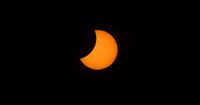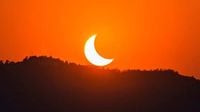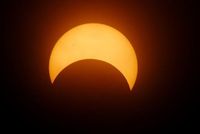The world will witness its first solar eclipse of 2025 on Saturday, March 29, which will be visible across much of North America, Europe, northern Africa, and parts of Asia. This partial solar eclipse will occur between 5:51 AM and 9:44 AM GMT, with its peak at approximately 7:47 AM. The Royal Observatory Greenwich will stream the event live on its official YouTube channel, allowing enthusiasts from around the globe to join in the celestial spectacle.
Unlike the recent lunar eclipse that captivated observers in March, this solar event will not be visible in Brazil, except for a very minor view from the northern region of Amapá. Here, the eclipse will only cover a small portion of the sun, rendering it almost imperceptible. However, in other parts of the world, the eclipse promises to be a more dramatic sight. For instance, in eastern Canada, observers may see up to 92% of the sun obscured, while in countries like Spain, France, and Germany, the coverage will be significantly less, around 17%.
A solar eclipse occurs when the moon positions itself between the Earth and the sun, partially blocking sunlight. In a partial eclipse, the celestial bodies are not perfectly aligned, resulting in a crescent-shaped sliver of sunlight remaining visible. This phenomenon can transform the sky into a surreal twilight, momentarily dimming daylight.
For those planning to watch the eclipse, safety is paramount. The National Observatory emphasizes the necessity of using appropriate filters, such as welder's glass rated number 14 or specially designed eclipse glasses. Ordinary sunglasses are insufficient for protection, and looking directly at the sun without adequate eye protection can lead to serious and permanent eye damage.
As for where the eclipse will be best observed, locations in the northeastern United States and parts of Canada are expected to offer prime viewing opportunities. For example, cities like Nuuk in Greenland will experience a significant eclipse magnitude of 0.892, while Halifax and St. John's in Canada will see 0.856 and 0.854 respectively. In the U.S., Presque Isle, Maine, will witness the eclipse at 6:21 AM local time, with a coverage of 85.40%. Other notable cities include Boston, Massachusetts, and New York City, where the eclipse will be visible shortly after sunrise.
In Europe, the conditions are more favorable for viewing, with many locations able to see the peak of the eclipse. Cities in the UK, Ireland, and Iceland are among the best spots, with Reykjavík expecting to cover 67.70% of the sun and Dublin around 41.28%. The timing for these locations will be around 11:05 AM GMT for Reykjavík and 11:00 AM GMT for Dublin.
Northwestern Africa will also witness the eclipse, though the percentage of the sun covered will generally be lower than in Europe. Countries like Morocco will experience visibility, with El Jadida seeing about 18.12% of the sun obscured.
As the eclipse approaches, many are gearing up to partake in this celestial event. Several apps, such as Eclipse Guide and Sky Tonight, can help observers track the eclipse's timing in their specific locations. These applications provide interactive maps and timelines, making it easier for enthusiasts to plan their viewing.
In conclusion, while the partial solar eclipse on March 29, 2025, may not be visible to everyone, it presents a unique opportunity for millions across various continents to engage with a spectacular natural phenomenon. As always, safety should be the foremost concern for anyone wishing to experience the event directly. With the right precautions and preparations, this eclipse could be a memorable highlight for many stargazers around the world.





